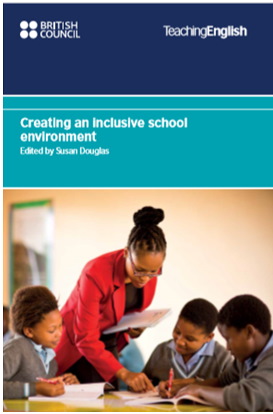Book Review: Creating an Inclusive School Environment
Marina Marinova is a teacher trainer and researcher in the field of second and third language acquisition. She works in association with a number of governmental and non-governmental institutions, among others Hamburg University, Pilgrims Teacher Training and Transform ELT. She is a regular speaker at conferences of the Hamburg English Language Teachers Association (HELTA) and has published in various ELT magazines and conference proceedings.

British Council, ISBN 978-0-86355-933-4
An electronic copy of the book can be downloaded from:
https://www.teachingenglish.org.uk/article/creating-inclusive-school-environment
Creating an Inclusive School Environment, edited by Susan Douglas, is a collection of reports on British Council projects around the world, related to inclusion, equity, fairness and equal access to quality education.
The reports are organised around four major topics: teaching refugee children (Displaced populations), gender inclusion, teaching children with special educational needs, and teaching ethnic minorities.
Three or more projects are represented in each section, in different countries and teaching contexts, from refugee camps in Iraq, through Nigeria, where teachers’ and pupils’ safety is greatly endangered by Boko Haram, to a comprehensive school in Germany.
Based on specific conditions and requirements, the projects focus on different aspects of inclusion and equity. Examples include integrating refugees in a country’s educational system and empowering them (Iraq, Greece, Lebanon, Germany) giving girls an access to education and a fair chance (Nigeria, Turkey, Nepal, and other countries across Asia and Africa), inclusive education of children with disabilities and special needs (Mexico, South Africa, as well as some countries in South- and East Asia), as well of children from minority groups and marginalised ethnic groups (Namibia, South Asian countries).
The projects presented in the book are of very different scopes. The large majority have been carried through in one country, often in cooperation with local authorities, and tailor-made to meet specific needs and problems. These include Safe School Initiatives in Nigeria, English for Resilience in Iraq, Living Together in Greece, Awakening to Languages in Lebanon, ETCEP in Turkey.
The smallest project in terms of human resources, if not in terms of implications, is the Story Telling one, initiated by David Heathfield.
A common aspect of all projects is the profound understanding of the complex nature of inclusiveness and the variety of social, political and personal factors that need to be addressed, to achieve a truly inclusive teaching and learning environment.
The different teaching realities are presented realistically and non-judgementally, the problems are not “beautified”, nor are they deemed unsolvable. The same is true about the effects and limitations of the projects.
Special emphasis is laid on the role of teachers as “first responders” and crucial forces in the way to creating an inclusive school environment. The need for special training, voiced by teachers, is a red thread throughout all project presentations.
Who would benefit from reading this book? At first glance, this is a highly specialised text for people involved in the above and other projects. Numbers and statistics are usually interesting only for people directly affected by them. I feel, however, that many of the reports can be helpful for teachers, who deal with the problems reflected here. The “Awakening to Languages” project, for example, comes with valuable information about problems refugee children and their parents are likely to face everywhere, as well as practical ideas and suggestions about empowering these children, involving parents in the educational process, raising understanding for these children’s specific problems among students and teachers, and enhancing acceptance.
The Story Telling project offers ideas for practical implementations of tales in a classroom.
Theatre in The Classroom offers strategies for changing classroom dynamics, where inclusive teaching is seen as problematic, even impossible.
All projects reflect the importance of teacher training and support for teachers, and address their anxieties. Teachers may find their own thoughts in worries in some of the statements quoted in the book. This can help them realise they are not alone, can encourage them to voice doubts and ask for support. At the same time, it may be helpful to hear the voices of the “other side”, be it refugees, children from minority groups, traditionally seen as adverse to mainstream education, or children with special needs. Ideally, this may encourage a re-evaluation of one’s own beliefs about these children, change of attitude and awareness for one’s own biases.
Policy makes may get useful insight into possibilities to set up similar projects in their countries or educational institutions.
The reports differ in style and level of detail, but they can all inspire teachers and policy makers to put a stronger emphasis on inclusive education, by outlining realistic possibilities for improvement, even in the most adverse of circumstances.
Please check the Creating an Inclusive School Environment course at Pilgrims website.
Please check the How to Motivate Your Students course at Pilgrims website.
Book Review: Creating an Inclusive School Environment
Marina Marinova, GermanyShort Book Reviews
Hania Kryszewska, PolandLeading Multimedia and Electronic Publisher Mrs Wordsmith Launches Interactive Video Game to Improve Children’s Vocabulary
Tune into English
Fergal Kavanagh, ItalyTo the Pedagogical Activists of the World